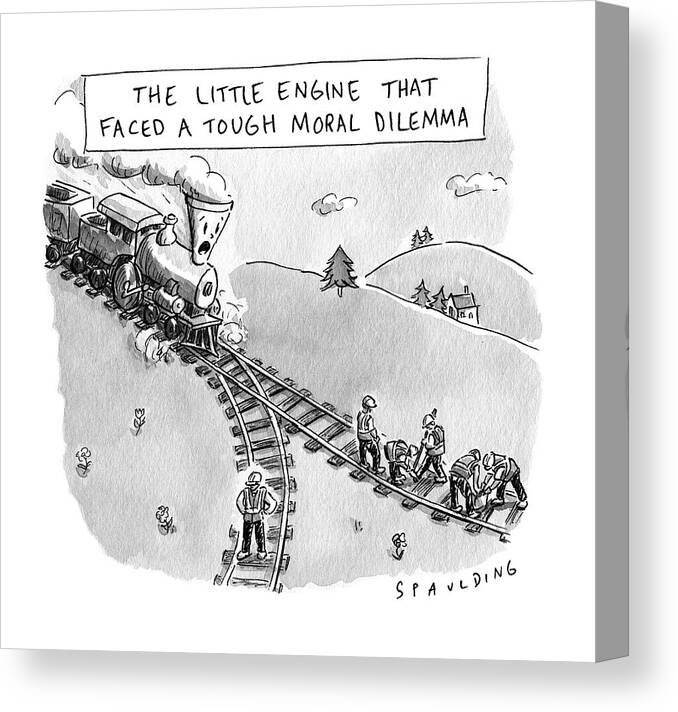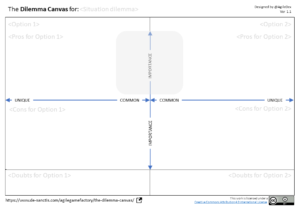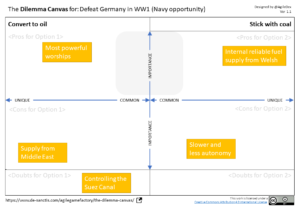Very often, while coaching teams or leaders, but also while designing new games, I face some dilemmas.
This article is collecting some information could help to solve these kind of blocking situations, and in particular it is focused on presenting a canvas you can use to manage these situations, and maybe finding a solution.
A dilemma is …
First lets clarify what a dilemma is: a dilemma (Greek: δίλημμα “double proposition”) is a problem offering two possibilities, neither of which is unambiguously acceptable or preferable (quoted from wikipedia, link).

Special “historical” references
There is a lot of literature on dilemma solution. The best reading I have found is a small book by Clarke “the bottleneck guy” Ching: Corkscrew solutions (link to amazon). If you are interested in video introduction, Clarke has been guest ot LADCnet community to present the book, and his session is available on youtube in the LADCnet channel (link).
I strongly suggest to watch the section talking about Winston Churchill in WWI (min 11:30 for 20′). Here you can find another framework to work with dilemmas, that actually inspire this article. However one of the outcomes you can find is the introduction of BoB: Best of Both.
Corkscrew thinking is how Churchill named this approach, where you can analyse a dilemma to find a solution that can leverage the Best of Both (BoB) situations.
It is also interesting to note that, always during WWI, the corkscrew thinking has been applied also to try to disrupt the stuck of the trenches war in the western front. In this case the solution was about opening a second eastern terrial front in Turkey so to defeat the weakest German ally(1), split the german effort in another front (2), and open a logistic connection with Russia (3), a strong British ally. Unfortunately in this case the solution has been a complete failure and it leaded to the disastrous defeat of Gallipoli ( link to youtube video)
The new canvas
Here the image of the canvas that can be downloaded as PDF here (link)

The Canvas is a matrix where you have the 2 options in two columns.
For each of the options you have 4 areas
- Name: to identify the option
- Pros: to collect all positive attributes (benefits)of the option
- Cons: to collect all negative attributes (disadvantages) of the option
- Doubts: to list the open points requiring a clarification
Also there are some cartesian dimensions that help you placing the attributes and understanding their real impact. As you can imagine the grey are in the middle helps you finding the BoB that is the grey area in the middle.
How to use the Dilemma Canvas
As many other canvases, the areas are there to engage and facilitate the brainstorming.
The main usage is to give specific areas collect in the different areas thoughts about the two options. However the canvas let you also place these ideas in different position following prioritisation (importance axis) and the unicity. The grey area let you understand what attributes are not unique and maybe could be achieved by both solutions, or, eventually, a path to identify a third solution that could achieve both.
My suggestion is to create the canvas in a whiteboard and place each attribute as a separate sticky, placing them in accordance with your estimation about the dimensions. If during the analysis, more similar to an exploration of the possibilities, some questions rise, you can list then in the “doubts” are, where, once clarified, you can move them in Pros, or Cons.
For example this is the application of the canvas to the situation described by Clarke “the bottleneck guy” Ching in the LADCnet video mentioned above.

One of the advantages of this canvas, is that you can use splitting vertically, analysing in details one of the options, or horizontally, analysing only Pros (or Cons) of the two options. In this way you can focus on the content following the approach you prefer.
Q: What if you are facing more than two possibilities?
Even if these are not exactly di-lemmas, what is written here works, because the canvas is able to scale, if required.